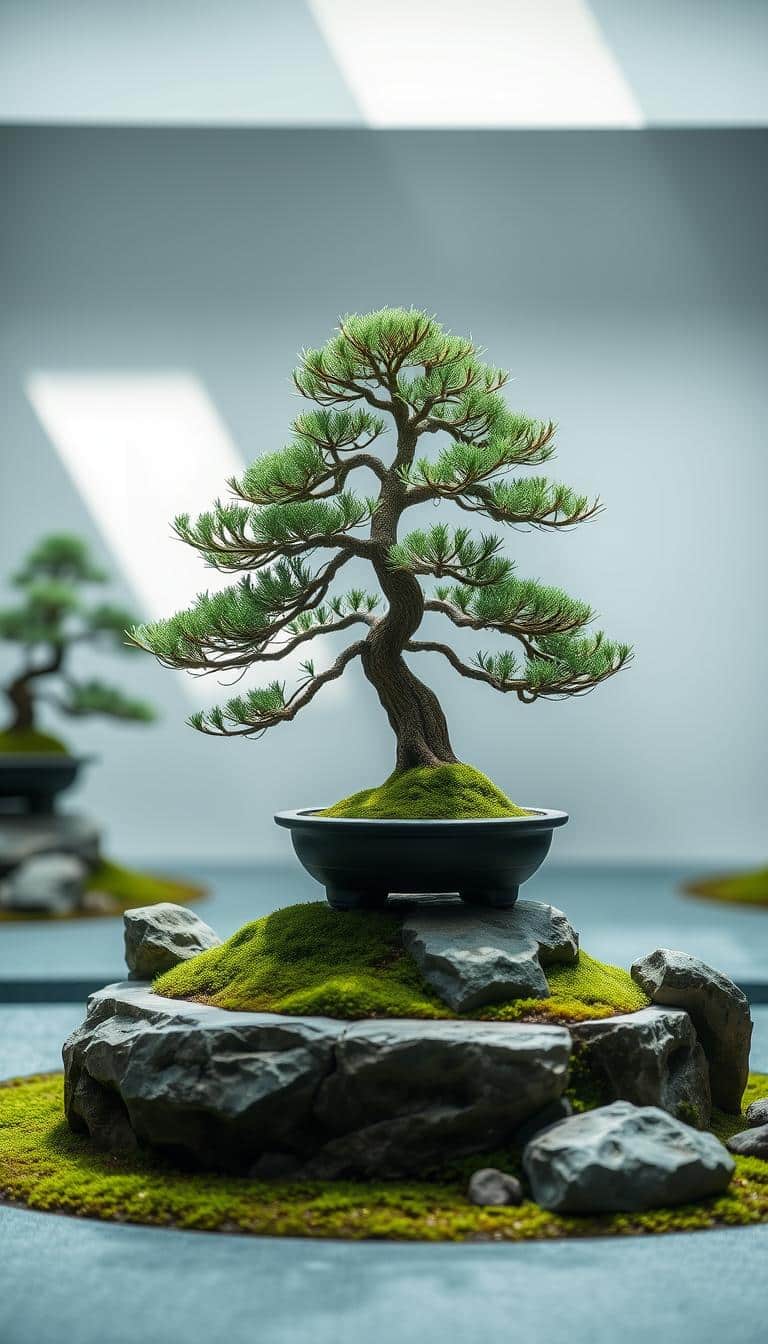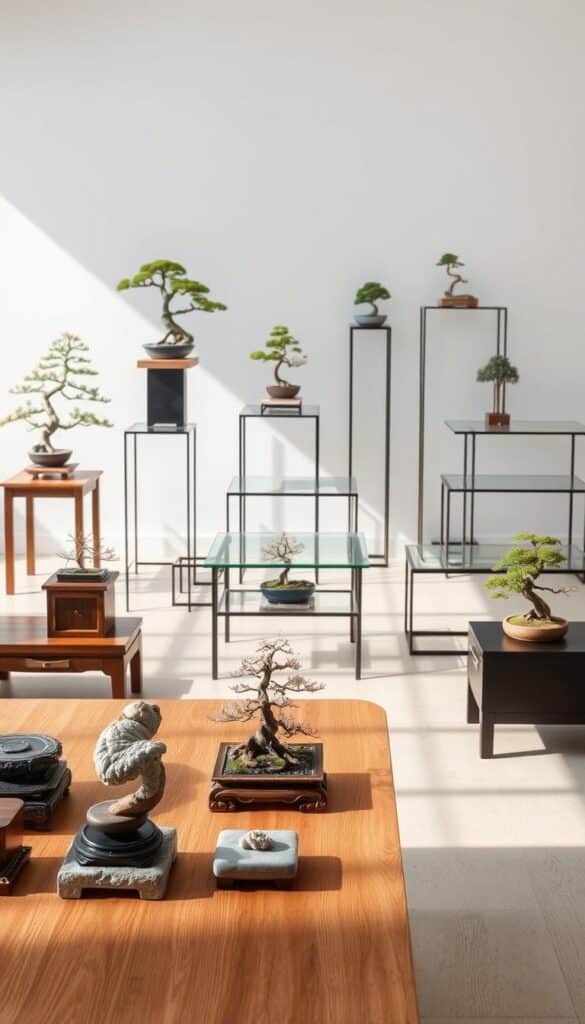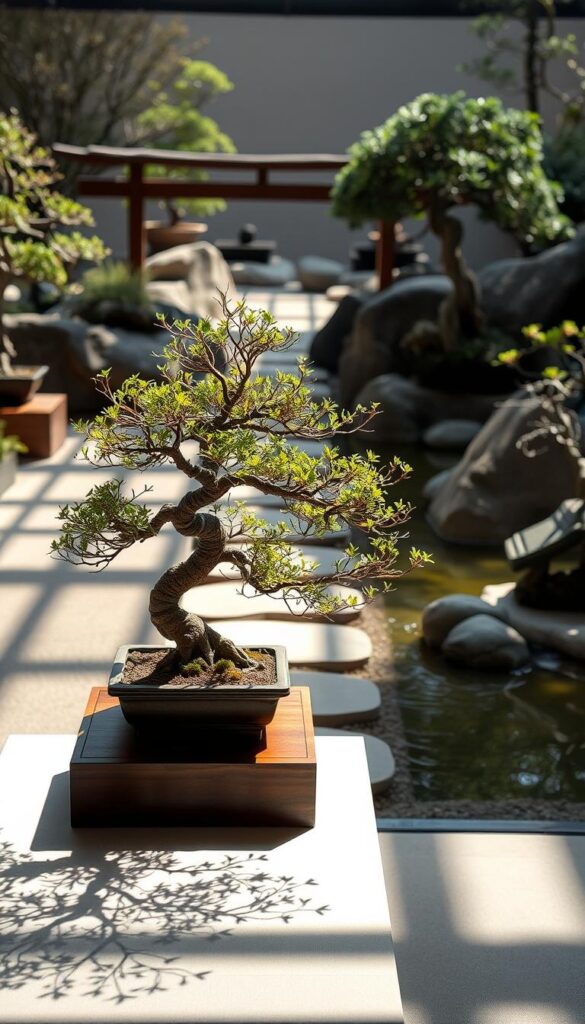Imagine walking into a room where a small tree sits in perfect harmony with its surroundings, telling a story of nature and art. This is the magic of bonsai display. For me, it all began when I first saw a bonsai tree in a friend’s garden. It wasn’t just a plant; it was a living sculpture that sparked curiosity and admiration.
The art of displaying bonsai is more than just placing a tree in a pot. It’s about creating a connection between nature and human creativity. When done well, it transforms a simple tree into a meaningful piece of art that reflects the owner’s personality and appreciation for tradition.
Displaying bonsai is a journey, not a destination. It’s about understanding how to combine the tree, pot, and stand in harmony. This craft is deeply rooted in tradition, yet it offers endless opportunities for personal expression. In this article, I’ll share insights and practical advice to help you master the art of bonsai display, ensuring your tree becomes a stunning centerpiece in your home.
Understanding the Art of Bonsai Display
For me, bonsai display is a deeply personal and meditative process. It’s about creating a harmonious connection between nature and artistry. Every tree, pot, and stand tells a unique story, and the way they’re presented can elevate the entire experience.
What Bonsai Display Means to Me
Growing up, I was captivated by the elegance of bonsai trees. Over time, I realized that the display is just as important as the tree itself. It’s not just about placing a tree on a stand; it’s about crafting a moment that invites the viewer to pause and appreciate the beauty in simplicity.
The Cultural Roots and Aesthetic Philosophy
Rooted in Japanese tradition, bonsai display reflects principles like harmony and balance. The tokonoma style, with its uncluttered spaces, contrasts beautifully with larger exhibition setups. This blend of tradition and modern techniques keeps the art form vibrant and evolving.
| Display Style | Key Features | Viewer Experience |
|---|---|---|
| Traditional Tokonoma | Minimalist, focused on simplicity | Creates a serene, contemplative atmosphere |
| Modern Exhibition | Dynamic, often with complementary elements | Engages the viewer with a broader artistic context |

The Art and Practice of Displaying Bonsai
My journey into the world of bonsai began with a single tree that captivated me. What I love most is how each step of the process feels like storytelling. From pruning to wiring, every action shapes the tree’s narrative.
Choosing the right pot and stand is a creative way to enhance the tree’s natural beauty. It’s like framing a painting; each element adds depth to the story. The space around the tree is just as important, creating a sense of balance and harmony.
The feeling I get from this art form is meditative, much like the gentle flow of water. It’s a way to connect with nature and find peace. Each tree has its own character, and my role is to bring that out in a way that feels authentic and meaningful.
Respecting the tree’s natural form is essential. I see myself as a guide, helping the tree express its unique spirit. This process is a part of who I am, blending tradition with personal expression in every display.
Choosing the Right Bonsai Tree for Display
Selecting the right bonsai tree for display is a crucial step in creating a captivating arrangement. It’s about finding a tree that resonates with your design vision and tells a story. For me, it’s like choosing a main character for a narrative.
Assessing Age, Health, and Proportions
When evaluating a bonsai tree, I start by examining its age, health, and proportions. An older tree often has more character, with a trunk that tells a story of time and care. Health is vital; the tree should have vibrant foliage and a sturdy structure. Proportions matter too—each branch and leaf should be in harmony, creating a balanced look that draws the eye naturally.
Matching Tree Style with My Vision
My design philosophy is all about integrating the tree’s natural beauty into a larger artistic narrative. I look for a tree that fits my creative vision, whether it’s a formal, structured style or a more free-spirited, natural look. The tree’s style should complement the space where it will be displayed, creating a sense of harmony.
Scrolls play a complementary role, enhancing the tree’s story. They add depth and context, inviting the viewer to explore the narrative further. By matching the tree’s style with my vision and incorporating elements like scrolls, I create a cohesive display that feels intentional and meaningful.
Designing an Impactful Bonsai Composition
Crafting a compelling bonsai display is all about balance and harmony. It’s like orchestrating a symphony where each element—tree, pot, stand, and accents—plays a vital role. I’ve found that when these components come together seamlessly, they create a cohesive and visually stunning arrangement that draws the viewer in.
Harmonizing the Tree, Pot, and Stand
The foundation of a great display lies in how well the tree, pot, and stand work together. The pot should complement the tree’s size and style, while the stand adds stability and elevation. I’ve seen how the right wood choices for the stand can elevate the entire composition, giving it a natural, earthy feel that enhances the tree’s beauty.
| Component | Traditional Style | Modern Style |
|---|---|---|
| Tree | Emphasizes natural form and age | Allows for creative styling |
| Pot | Simple, earthy colors | Bolder, vibrant colors |
| Stand | Wooden, minimalist design | Metal or glass for a sleek look |
This balance ensures the tree remains the focal point while the pot and stand enhance its presence without overpowering it.
Integrating Scrolls and Accent Elements
Add depth to your display with scrolls and accent pieces. These elements tell a story and invite the viewer to explore further. I’ve used scrolls to add a touch of tradition, while accent plants or small decorative items bring in a modern flair.
| Element | Purpose |
|---|---|
| Scrolls | Provide cultural context |
| Accent Plants | Add color and texture |
| Decorative Items | Enhance the narrative |
Remember, every element should contribute to the overall show without distracting from the tree’s beauty.
By thoughtfully combining these elements, you can create a display that not only showcases your tree but also tells a meaningful story. It’s all about finding that perfect harmony where each part supports the whole, creating a display that truly stands out.
Preparing and Conditioning Your Bonsai for Display
Before showcasing your bonsai, proper preparation is essential to ensure it looks its best. This process involves careful pruning, wiring, and cleaning to highlight the tree’s natural beauty while maintaining its health.
Pruning, Wiring, and Pest Management
Pruning is the first step in preparing your bonsai. I focus on trimming branches to enhance the tree’s shape and size. This step ensures the tree maintains its proportions and visual appeal. Wiring comes next, allowing me to gently shape the branches without causing harm. It’s important to check the wires regularly to prevent damaging the bark.
Pest management is another critical aspect. Regular inspections help identify any issues early. Using the right fertilizers and cleaning methods ensures the tree remains healthy and pest-free.
Cleaning and Final Touch-Ups
Cleaning involves gently removing dirt from the leaves and trunk. This step ensures the tree looks pristine for display. Final touch-ups might include adjusting the pot or stand to enhance the overall presentation.
| Step | Action | Purpose |
|---|---|---|
| 1 | Pruning | Shape and size control |
| 2 | Wiring | Branch shaping |
| 3 | Pest Check | Ensure health |
| 4 | Cleaning | Remove dirt |
| 5 | Final Adjustments | Enhance presentation |
By following these steps, your bonsai will be perfectly prepared for a flawless display.
Selecting the Ideal Bonsai Stand and Table
Selecting the right stand and table for your bonsai is crucial for creating a balanced and visually appealing display. The stand not only supports the tree but also enhances its form and complements its natural lines. A well-chosen stand and table can elevate the entire composition, ensuring stability and harmony.
Choosing the Right Material and Style
When it comes to materials, wood is a popular choice for bonsai stands due to its natural beauty and ability to complement the tree’s form. Look for high-quality wood grain that adds texture and depth to the display. Metal and glass stands offer a modern aesthetic, but wood remains timeless. The style should match the tree’s lines and composition, creating a cohesive look.
| Material | Traditional Style | Modern Style |
|---|---|---|
| Wood | Natural, earthy feel | Polished, sleek designs |
| Metal | Minimalist designs | Contemporary looks |
| Glass | Not commonly used | Modern, sleek appearance |
Ensuring Stability and Proportionality
Stability is key to prevent the tree from toppling. The stand should be sturdy and proportionate to the tree’s size. A wider base provides better stability, while the height should elevate the tree without making it appear unbalanced. The table should complement the stand, creating a harmonious side view that enhances the overall display.

Curating Complementary Accent Elements
Accent elements are the subtle yet powerful details that elevate a bonsai display from beautiful to breathtaking. They add depth, contrast, and a touch of personality to your arrangement without overshadowing the star of the show—the tree displayed.
Integrating Accent Plants and Minimalist Decor
The right accent plants and decor can enhance the natural beauty of your bonsai. For instance, a small patch of moss or a delicate ground cover can add texture and color, creating a harmonious contrast with the tree’s foliage. These elements should complement the grain of the wood in your stand or table, ensuring a cohesive look.
When selecting accents, consider the tree’s style and the overall aesthetic you want to achieve. A minimalist approach often works best, as it allows the bonsai to remain the focal point. For example, a simple decorative stone or a tiny ceramic figurine can add interest without overwhelming the display.
| Element | Purpose | Example |
|---|---|---|
| Accent Plants | Add texture and color | Moss, small succulents |
| Decorative Items | Enhance the narrative | Small stones, ceramic pieces |
| Minimalist Decor | Support visual impact | Simple scrolls, subtle lighting |
Remember, every element should find its proper place in the arrangement. By thoughtfully selecting and placing these accents, you create a display that feels intentional and visually striking.
Mastering the Arrangement of Display Elements
Arranging display elements is where art meets strategy. As an artist, I’ve learned that every piece, from the bonsai stand to the smallest accent, plays a role in guiding the viewer’s attention. The goal is to create a harmonious flow that highlights the tree’s beauty while telling a story.
Positioning for Visual Impact
To capture attention, start by placing the bonsai stand as the focal point. Position it slightly off-center to create visual interest. Accent elements like scrolls or small decorative items should complement the tree without competing for attention. I’ve found that aligning the stand with the room’s natural traffic flow helps draw eyes to the display.
Balancing Negative Space and Focal Points
Negative space is your ally. It prevents clutter and keeps the focus on the tree. Use it to create breathing room around the bonsai stand and accents. The table or surface should be clean, with only essential pieces. This balance ensures the display feels intentional and artistically cohesive.
| Element | Role in Arrangement |
|---|---|
| Bonsai Stand | Central focal point, elevates the tree |
| Accent Pieces | Add context without distracting |
| Negative Space | Creates balance, prevents clutter |
By thoughtfully arranging each piece, you guide the viewer’s attention to the tree’s key features while maintaining a beautiful, artistic presentation. This approach reflects the sensibilities of a dedicated artist, ensuring every element contributes to the overall narrative.
Enhancing Your Display with Accessories and Lighting
Lighting and accessories can elevate your bonsai display, creating a captivating environment that draws the viewer’s eye to the center of your arrangement. These elements are essential for setting the mood and maintaining the delicate balance of your display without overwhelming it.
Using Lighting to Evoke Mood
Lighting plays a crucial role in highlighting the bonsai’s features. Soft, indirect light can create a serene ambiance, while strategically placed spotlights draw attention to specific details. I’ve found that positioning the light source slightly above the tree enhances its natural contours, guiding the viewer’s gaze to the center of the display.
Showcasing Accessories without Overcrowding
Accessories like scrolls or small decorative items add depth to your display. To maintain harmony, arrange them in a way that creates a sense of order. For example, placing a scroll near the base of the stand can complement the tree without distracting from it. The key is to keep the arrangement simple, ensuring the bonsai remains the focal point.
- Use lighting to highlight the tree’s natural beauty.
- Add accessories sparingly to avoid clutter.
- Position the bonsai at the center to draw attention.
By thoughtfully integrating lighting and accessories, you create a display that feels intentional and visually striking, keeping the viewer engaged and focused on the artistry of your bonsai.
Exhibiting Your Bonsai in Diverse Settings
Exhibiting bonsai trees in various settings can truly bring out their unique charm. Whether it’s a bustling day at a garden show or a quiet year ago display in a private gallery, each venue offers a distinct opportunity to connect with audiences.
Exploring Exhibition Styles: Chinretsu-Kai and Kazari
Chinretsu-Kai exhibitions focus on natural, simplistic arrangements, often featuring a single tree. This style emphasizes the tree’s intrinsic beauty. On the other hand, Kazari displays are more elaborate, incorporating decorative elements like scrolls and accent plants to create a vibrant, dynamic atmosphere.
Adapting Your Display for Different Venues
When preparing for a show, consider the venue’s size and atmosphere. For large spaces, a Kazari display can captivate the crowd. In intimate settings, a Chinretsu-Kai arrangement creates a serene ambiance. I recall a day when a simple setup in a small gallery drew as much admiration as a grand exhibition.
Practical considerations include ensuring the tree’s health and stability. A year ago, I learned the importance of careful wiring and pruning to maintain a tree’s appearance during transport. These lessons have been invaluable for exhibitions.

By thoughtfully adapting your display, you can share the beauty of bonsai in any setting, making it a memorable experience for all who visit.
Final Reflections on Crafting Your Bonsai Display
Reflecting on my journey with bonsai, I find immense fulfillment in the artful process of creating a display. It’s more than just arranging a tree; it’s about crafting a story that resonates with everyone who sees it. Each step, from selecting the tree to placing the final accent, is a deliberate choice that brings the vision to life.
To create a cohesive vision, make sure every area of your display is thoughtfully arranged. The arrangement of the tree, pot, and stand should harmonize, while accents like scrolls or small plants add depth without distracting. Remember, the goal is to guide the viewer’s eye through the display, ensuring each element complements the others.
As you refine your technique, appreciate the unique process of displaying tree masterpieces. It’s a journey of growth and creativity. I invite you to share your experiences and insights, as a well-crafted display speaks volumes about an artist’s dedication. In my own journey, I’ve seen how this art form evolves, blending tradition with personal expression. Embrace the process, and let your passion shine through every arrangement.
